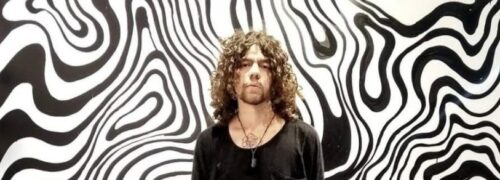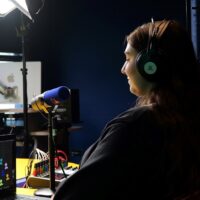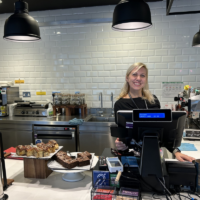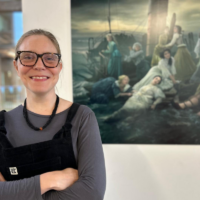
People
Meet the Dockers: Luke Gray
Luke Gray is a talented painter and muralist whose work weaves together powerful stories of heritage, migration, and identity. With deep roots to the Royal Docks, Luke’s art is influenced by the area’s rich history and vibrant cultural tapestry. His latest project, Threads of Arrival, part of Royal Docks Originals is a striking mural celebrating the diverse communities and migrant narratives that have shaped Newham and the Royal Docks. In this Meet the Dockers interview, Luke shares insights into his creative process, the inspiration behind his work, and what it means to contribute to Royal Docks Originals, a free arts festival taking place in the Royal Docks until 4 October 2025.
Tell us about yourself and your connection to the Royal Docks.
I’m Luke Gray, a travelling surrealist painter and muralist, now working internationally on public art projects. I studied at the University of East London’s Docklands campus and graduated from there with a degree in Graphic Design, so the Royal Docks were part of my formative years as an artist. My practice is about weaving stories of heritage, migration, and identity into large-scale murals. The Royal Docks, with their deep history of movement and exchange, feel like the perfect place to root a project about arrival and belonging. My grandfather migrated from the Caribbean in the 1960s amongst the first waves of the wind-rush generation, so I am also very grateful to be able to depict a piece of that history and celebrate those migrants who helped build this country.
Tell us about Threads of Arrival and the inspiration behind it?
Threads of Arrival is a mural inspired by the idea of textiles as carriers of history. Just as ships once carried fabrics, spices, and people to the Royal Docks, I see cloth as a metaphor for identity, woven from many different origins. I want to highlight the stories of migration that shaped Newham: Indian seafarers, Irish and Caribbean dock workers, South Asian textile traders, and the countless families who arrived here in search of opportunity. The mural is both a patchwork of global patterns and a local portrait of resilience and contribution.
The Royal Docks, with their deep history of movement and exchange, feel like the perfect place to root a project about arrival and belonging. My grandfather migrated from the Caribbean in the 1960s amongst the first waves of the wind-rush generation, so I am also very grateful to be able to depict a piece of that history and celebrate those migrants who helped build this country.
What techniques and materials will you use to create the mural?
I’ll be hand-painting the entire mural using masonry paint and brushes, working from scaffolding with ladders, buckets, and a measuring tape always close at hand. For the more difficult areas of brickwork at the top, I’ll use spray paint to get a clean, even finish. The mural will be built up in sections almost like a giant screen print: I’ll block in large areas of colour first, then layer different tones and patterns on top, gradually building up the final image. Each layer adds depth, from the bold background fields to the finer textile motifs and details that tie everything together.
What are the biggest challenges of creating a large-scale mural like Threads of Arrival?
Scale itself is always a challenge both logistically, physically and creatively. Working on larger walls mean balancing detailed storytelling with imagery that works both close and from a distance. There’s also the challenge of making it accessible, ensuring the patterns resonate with the local community, rather than becoming just decoration. And practically, it’s about working around scaffolding, staggering paint drying times, moving materials to the site and back into storage each day, the weather, and deadlines all while holding onto the spirit of the piece.
What impact do you hope Threads of Arrival will have on visitors and members of the local community during the festival and also in terms of legacy?
I hope it becomes a point of pride, something where local residents can see their heritage reflected, and visitors can get a sense of the global richness of the Docks. In the short term, I want it to spark conversations, “That pattern is from my homeland,” or “My grandfather worked on those ships.” In the long term, I hope it acts as a visual landmark that reminds future generations of the creativity, resilience, and diversity that built Newham.
In the short term, I want it to spark conversations, “That pattern is from my homeland,” or “My grandfather worked on those ships.” In the long term, I hope the mural acts as a visual landmark that reminds future generations of the creativity, resilience, and diversity that built Newham.
What does it mean to you that Threads of Arrivals is part of Royal Docks Originals?
It’s a privilege. Royal Docks Originals is about celebrating creativity rooted in this place, and for me, Threads of Arrival belongs to the community as much as to my own practice. Being included in that programme affirms the importance of telling stories that are both deeply local and globally connected.
How do you feel Royal Docks Originals can contribute to building a creative future locally?
By embedding art in the daily landscape, Royal Docks Originals creates a sense that creativity is not separate from life, it’s part of it. The more opportunities residents have to engage with artists, share their own stories, and see their neighbourhood transformed by artists, the more a creative culture takes root. It helps inspire the next generation to feel that art is for them, not just something imported from elsewhere or for the upper classes.
What are you most looking forward to at Royal Docks Originals, or do you have a favourite piece (besides your own work)?
I’m most looking forward to seeing how other artists respond to the site whether that’s through performance, installation, or storytelling. The diversity of practices is what excites me, I don’t have a favourite yet, but I’m always on the lookout for exciting new artists, who are trying to push the medium.
Sum up Royal Docks Originals up in one word.
Threads of Arrival is part of the Docks Open Art Commissions curated by Hive Curates.


